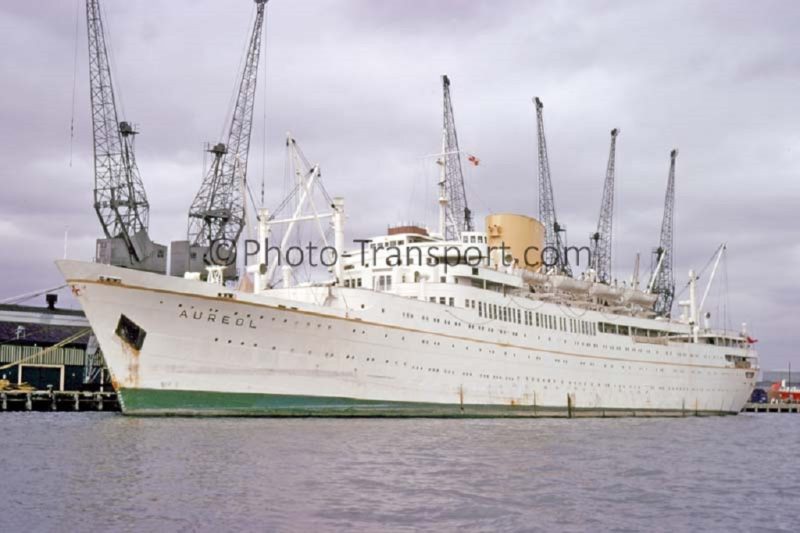
The European colonial powers of Great Britain, Germany, Belgium, France and Holland sent explorers, plantation owners, company agents, servants and government administrators to their West African colonies for over one hundred and fifty years. The main shipping lines that carried them were Elder Dempster Lines of Liverpool, Woermann Line of Hamburg, Hamburg America Line, Norddeutscher Line of Bremen, Compagnie Maritime Belge of Antwerp, and Holland West Afrika Lijn of Amsterdam. The main three lines carrying passengers that lasted for one hundred and fifty years on the coasts of the ‘white man’s grave’ colonies of West Africa were Elder Dempster Lines of Liverpool, Woermann Lines of Hamburg, and Compagnie Maritime Belge of Antwerp, and the passenger liners of these three lines are now discussed in some detail.
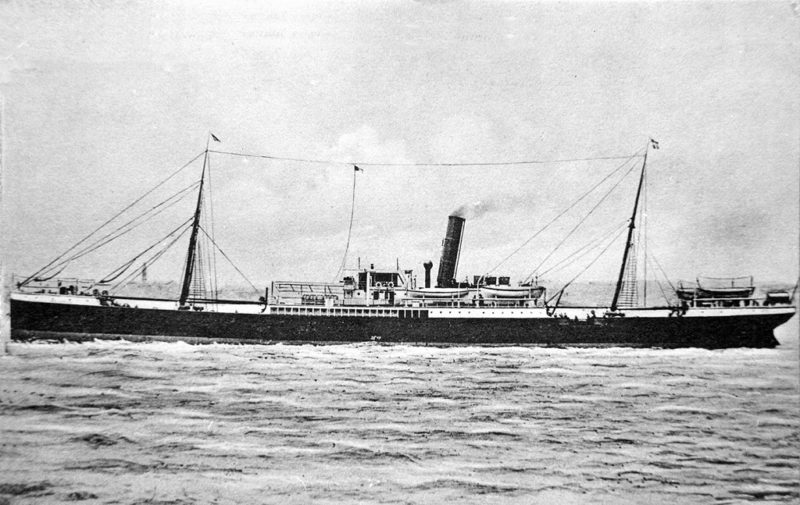
ELDER DEMPSTER LINES of LIVERPOOL
Laird (1809-1861) was the second son of Birkenhead shipbuilder William Laird, with his yard later merged to become the great Cammell Laird yard of high renown. He led an expedition party of 48 men from Liverpool including 2 doctors to explore what is today Nigeria and to prove that the Niger river was navigable by ocean trading vessels as far inland as 500 miles. The expedition lasted from September 1832 to August 1833, and only 9 men returned to Liverpool, with 39 dying in the Niger delta and further inland to malaria and tropical diseases, hence the term “white man’s grave”. Macgregor Laird survived but in a weakened state and convalesced on the Spanish island of Fernando Po before arriving back in Liverpool on New Years Day 1834. He died in 1861 after trading posts had been set up at Eboe, Onitsa and at Lokoja as well as upriver at Jebba. The island city of Lagos was declared a British Protectorate in that year in an attempt to stem the river slave trade based at Lagos, with Royal Navy patrols starting up the Niger.
Alexander Elder and John Dempster set up Elder, Dempster & Company on 1st October 1868 as agents for the British & African Steam Navigation Company, which competed with the earlier West African trading company of the African Steam Ship Company. The coastal steamer Eboe of 653 grt was completed in 1870 at Liverpool for the West African passenger and cargo feeder service in the Niger delta with a white hull and a yellow funnel. Three dozen passenger and cargo ships were completed between 1870 and 1895 for West African trading, named Nigretia, Elmina, Monrovia, Cameroon, Benguela, Corisco, Kinsembo, Gaboon, Lualaba, Sherbro, Congo, Niger, Opobo, Roquelle, Benin, Palmas, Boma, Matadi, Soudan, Coomassie, Cabenda, Angola, Dahomey, Ethiope, Loango, Bonny, Loanda, Volta, Accra, Bathurst, Axim, Batanga, Bakana, Ilaro, Landana and Banana of 1895. Biafra of 1895 and of 3,363 grt was the first proper passenger liner in the Elder, Dempster fleet with accommodation for 75 First Class passengers and 30 in Second Class.
All of the previous fleet carried only 30 to 40 passengers, which were almost always made up of company agents, staffs and their servants. Fifteen of this early fleet became marine losses with Nigretia making only two complete voyages to West Africa when she was lost on 14th June 1873 on Carpenter’s Rock at Freetown within sight of the protecting lighthouse while steaming too close to shore. Monrovia of 1873 followed her onto the same rocks three years later on 8th August 1876 and was a total loss.
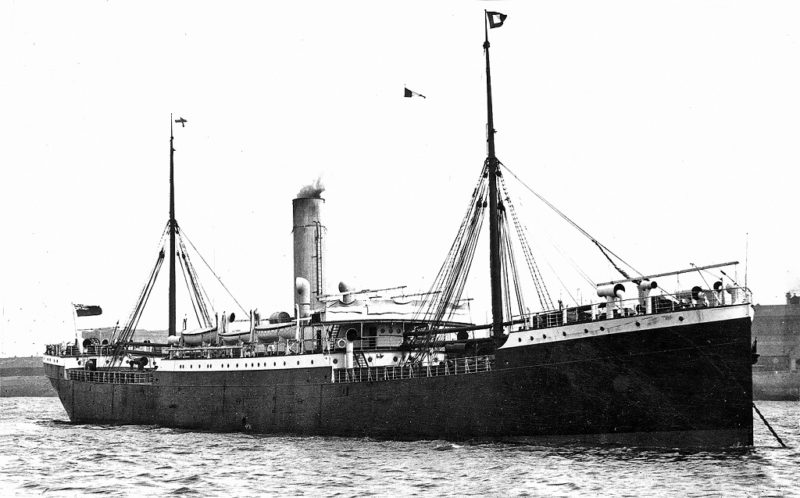
British Government officials and businessmen then began to use the Elder, Dempster passenger services to West Africa from Liverpool from 1895, calling at Santa Cruz de Tenerife, Las Palmas de Gran Canaria, Freetown, Monrovia, Accra, Sekondi, Takoradi, Tema, Calabar, Bonny, Port Harcourt, Lagos, Apapa, Banana and Boma. A class of nine passenger liners was completed between 1898 and 1902 as Olenda, Oron, Sokoto, Bornu, Jebba, Sekondi, Eboe, Nigeria and Akabo with accommodation for up to 108 First Class passengers and 52 in Second Class by yards at Glasgow, Barrow and Middlesbrough. This class took nineteen days to reach the Niger delta, and were the forerunners of sixteen passenger ships with similar profiles and interior layout e.g. the First Class Dining Room was at the forward end of Bridge Deck.
The passenger and cargo-liners Sobo, Fantee, Dakar, Elfreda, Mandingo, Burutu, Tarquah, Zaria, Muraji, Zungeru, Landana, Karina, Mendi, Falaba and Fulani (renamed Elmina in 1910) were completed between 1899 and 1906 with accommodation for up to 138 First Class passengers and 72 in Second Class with a crew of 96. Mendi and her sister Karina had accommodation for 100 First Class passengers and 70 in Second Class. The coal bunkers of Dakar caught fire at Forcados on 31st March 1915, and although damped down the heat caused a fire in her cargo and she was burnt out ‘midships. She was eventually salvaged in 1919/20 and reduced to cargo only and sold to Dutch owners. Muraji also caught fire in her bunkers and it eventually became out of control in late July 1914 on a voyage to West Africa and she sank at Grand Bassam in the Ivory Coast on 10th August 1914.
The two principals of the great Elder, Dempster & Company retired early from active ship management in 1884, with Alexander Elder only aged 50 years, and John Dempster only 47 years. The reins of the company were taken up by the great financier and their partner, Sir Alfred Jones, who then by a series of share purchases was able to merge the fleets of the British & African Steam Navigation Company and the African Steamship Company into one great fleet. The funnels of the African Steamship Company were black and only changed to the yellow of the British & African Steam Navigation Company in the 1920s decade after the merger of Elder, Dempster into the Royal Mail Line Group. Elder Dempster was by far the biggest component in the Royal Mail Line combine, and at the time of the death of Sir Alfred Jones on 13th December 1909 and the subsequent formation of Elder, Dempster & Co. Ltd. on 31st March 1910, had a capital of £1.91 million and owned 109 ships of over 300,000 grt. The biggest number of shares were held by Sir Owen Philipps of Royal Mail Line and Lord Pirrie of Harland & Wolff Ltd., thus this huge fleet became part of Royal Mail Line.
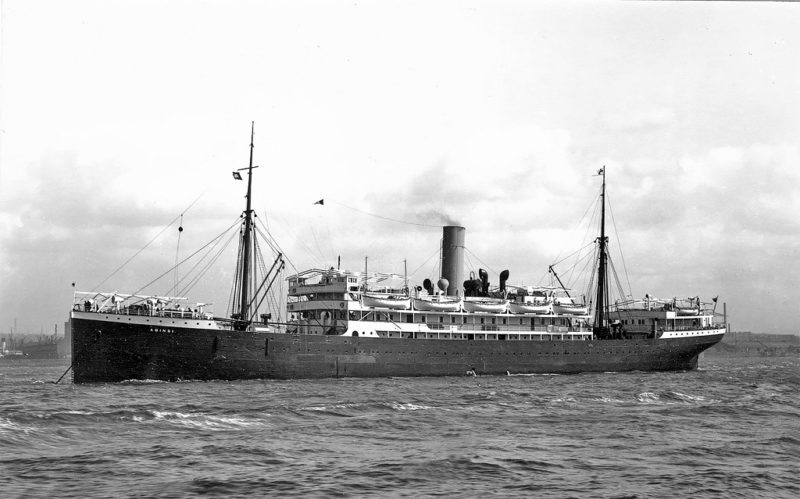
‘A’ class passenger liners entered the Elder, Dempster & Co. Ltd. fleet in 1912 with Abosso of 7,782 grt with accommodation for two hundred First Class passengers and 200 in Second Class, followed by her two sisters from Harland & Wolff Ltd. yards in Appam and Apapa of 1913/14. They had dimensions of overall length 425.6 feet, moulded beam of 57.3 feet, and moulded depth of 31.4 feet, and twin quadruple steam expansion engines drove twin propellers to give a service speed of 14 knots. This trio of ‘A’ class names shared the same ‘A’ class nomenclature of Royal Mail Line for their big passenger liners e.g. Aragon of 1905, Amazon of 1906, Araguaya of 1906, Avon of 1907, Asturias of 1908, Arlanza of 1911, Andes of 1913, Alcantara of 1914 and Almanzora of 1915. Subsequently, many British shipping companies differentiated their passenger liners as ‘A’ class ships, with ‘B’ class ships for cargo ships e.g. the Elders & Fyffes for their banana ships, although the names of their passenger liners were not strictly ‘A’s. A fourth slightly smaller passenger liner was transferred from the CMBC of Belgium to become Abinsi in 1914 of 6,365 grt, and had been completed in 1910 by the Harland & Wolff Ltd. yard at Belfast with accommodation for 170 First Class passengers and 18 in Second Class.
Abosso and Apapa became war losses in 1917, with Appam captured by the German armed merchant cruise Moewe in January 1916 when 135 miles east of Madeira while on a voyage from Freetown to Liverpool with £2 million in gold bullion and 40 German prisoners taken in the Cameroons. She was sent into Newport News together with all of the prisoners taken by Moewe from other captures. A legal dispute followed until April 1917 when Appam was returned to Elder, Dempster and renamed Mandingo in case of German reprisals. The Liner Requisition Scheme ended on 19th February 1919, and Appam regained her original name and sailed along with the new ‘A’ class liners of the inter-war years, Aba of 1920 but completed as the funneless motorship Glenapp in 1918, Adda of 1922, Accra (2) and Apapa (2) of 1926/27, Achimota of 1931, and Abosso (2) of 1936. All of this new great ‘A’ class were motorships and were given grey hulls in 1927 and with yellow funnels looked every inch the part of powerful ocean passenger liners in the Elder, Dempster publicity cards for the service to and from West Africa in the inter-war years. Abosso (2) had accommodation for 550 passengers and her twin screw diesel engines of 7,200 bhp gave her a service speed of 15 knots.
Appam was broken up at Milford Haven in 1936, and was replaced by the motorship Abosso (2) from the Cammell Laird yard in Birkenhead, Achimota having been sold in September 1932 for £346,376 to Huddart, Parker & Company of Melbourne and renamed Wanganella. The maximum combined passenger capacity in 1936 on the Liverpool to Lagos and Apapa express service of Aba, Adda, Accra (2), Apapa (2) and Abosso (2) were 1,186 passengers in First Class, 358 in Second Class, and 198 in Third Class, with five crews totalling 685 men. These five ‘A’ class express passenger liners with service speeds of 15 knots revolutionised the West African run, and had bunker fuel oil capacities of up to 1,150 tonnes enough for a round voyage.
The 7,781grt Appam was built in 1913 by Harland & Wolff at Belfast for Elder Dempster. From 1917 until 1919 she was renamed Mandingo before reverting to Appam. On 26th February 1936 she arrived at Milford Haven to be broken up by T.W. Ward. (John B. Hill collection)The only survivor out of five passenger liners in the Second World War was the veteran Aba, which gave sterling service in the Eastern Mediterranean as a hospital ship but was only fit for the breakers yard in 1946. Adda was torpedoed and sunk outside Freetown at 0400 hours on 8th June 1941 by U107, with rescue craft sent out from the harbour and they picked up all but two passengers and ten crew out of 419 passengers and crew onboard. Abosso (2) sailed from Cape Town on 8th October 1942 with 100 passengers onboard including naval ratings and 182 crew, but was torpedoed while unescorted on 29th October when 700 miles N. W. of the Azores by U575 in heavy seas and darkness, with only 31 people picked up next day by a corvette with 83 passengers and 168 crew lost.
Accra (2) sailed outwards in a convoy of 30 ships bound for West Africa as Vice Commodore ship but was torpedoed south west of Rockall on 26th July 1940 when 300 miles west of Ireland by U34. She took an hour to sink even though her engine room, promenade deck and two lifeboats out of four had been destroyed by the explosion, with the loss of 19 people from 333 passengers and 163 crew. Apapa (2), her sister, fared no better on 15th November 1940 when en-route from Freetown to Liverpool in convoy SL53 in that a Focke Wulf Condor aircraft dived down to only 150 feet to deliver delayed action bombs that completely wrecked the engine room, passenger cabins and number three hatch and hold, and she sank engulfed in flames and smoke with the loss of 24 people from 261 onboard some 200 miles west of Achill Head, County Mayo.
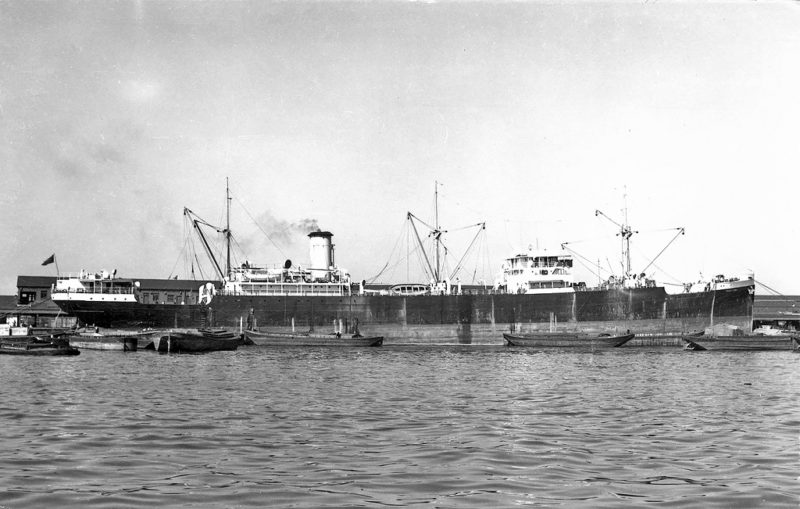
Two motorships were ordered at the end of the war in May 1945 from the Barrow yard of Vickers Armstrong Ltd. as replacements, with Accra (3) launched first on 25th February 1947 at a cost of £900,000. She made her maiden voyage on the three weekly service to Lagos from Liverpool on 24th September 1947, with Apapa (3) following on 11th March 1948 on her maiden voyage. The pair had dimensions of overall length of 471.0 feet, moulded beam of 66.2 feet, and moulded depth of 31.8 feet, with accommodation for 259 First Class passengers, two dozen in Second Class, and 145 deck passengers on the West African intercoastal service. Twin four cylinder opposed piston Doxford oil engines of a total of 9,400 bhp at 118 rpm gave a service speed of 16 knots, with two air brakes fitted to the propeller shaft to assist the reversing process, and saved seven ship lengths of forward movement. Accra (3) made 171 round voyages to Lagos until sold for breaking up in Cartagena in Spain on 8th November 1967. Apapa (3) made 177 round voyages until she found a buyer in November 1968 for a Hong Kong to Singapore and Penang service and was renamed Taipooshan with a white hull, and ran for just over six years until she arrived for breaking up at Kaohsiung on 28th February 1975.
Aureol was the last of the ‘A’ class for Elder Dempster Lines and in many ways the best, and upgraded their West African service to fortnightly after her delivery from the Linthouse yard of Alexander Stephen & Sons in November 1951. She had dimensions of overall length of 537.0 feet, moulded beam of 70.2 feet, and moulded depth of 32.2 feet, with accommodation for 253 First Class passengers and 100 in Cabin Class with a crew of 145. She made a two day guest cruise before sailing on 3rd November 1951 on her maiden voyage from Liverpool to Lagos. She had a service speed of 16 knots from twin four cylinder opposed piston Doxford oil engines of 10,800 bhp, burning diesel oil in harbour and switching to heavy fuel oil at sea. She officially inaugurated the Queen Elizabeth II Quay at Freetown on 1st May 1954, and was the first mail liner to berth at Takoradi Passenger Terminal on 24th August 1964. She was converted to a one class ship in 1968 after the sale of Accra (3) and Apapa (3), but with fuel prices increasing her U.K. terminal became Southampton on 26th April 1972 after the Liverpool Landing Stage was closed. She now made a round voyage of 29 days with ten sailings per annum. She was sold to Greek owners in early 1975 after making 203 round voyages to West Africa and was used as an accommodation hostel at Jeddah from March 1975 until moved to Rabegh, 125 miles north of Jeddah in 1980. She was laid up at Eleusis in Greece in 1989 and after twelve years of idleness was broken up at Alang in India in 2001.
Calabar and Winneba of 8,305 grt with accommodation for 108 one class passengers began a popular new monthly service from Tilbury to West African ports in April 1957. They had been completed on the Tyne during 1936/38 by Swan, Hunter & Wigham Richardson Ltd. as Umtali and Umgeni for Bullard, King & Company services to South Africa, and had survived the war after a few skirmishes with the enemy. The airlines displaced this pair in 1962, with Winneba making the final sailing on 3rd December 1962 to West Africa, and they were broken up in 1963 by shipbreakers at Inverkeithing and Antwerp respectively. An earlier Calabar of 1,932 grt in 1935 from the Belfast yard of Harland & Wolff Ltd. carried 40 First Class passengers, and a dozen in Third Class, with a crew of 35 on a weekly passenger service from Apapa to Douala in the Cameroons, the round trip taking eight days. The only time she returned to the U. K. was on 5th May 1953 at Liverpool for disposal to Epirotiki Lines of Greece, and she was renamed Semiramis.
A final mention must be made of Ebani and Eboe of 9,387 grt completed in 1952 by the Scott’s yard at Greenock for an unusual service from Canada and the U.S.A. to West Africa and South Africa. They carried only a dozen passengers, but their design had also allowed them to be converted into Armed Merchant Cruisers (AMC) in times of war. They were transferred to the Far East service of Blue Funnel Line in 1974 and were sold off in 1977 for further service of a few months for Eboe before she arrived at Gadani Beach for breaking up on 19th February 1978, while Ebani arrived at Faslane on 15th August 1977 for breaking up.
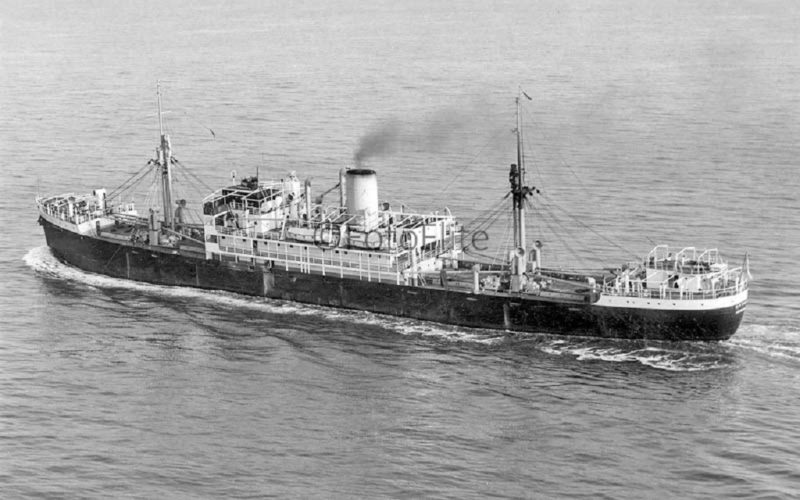
WOERMANN LINIE OF HAMBURG
Carl Woermann of Hamburg began to send three masted sailing ships to West Africa in 1847, with his first steamer arriving there in 1879. Adolph Woermann, his son, and the Woermann family also had trading interests in the region, and it became necessary to separate the shipping interests from these other businesses by setting up Woermann Linie A. G. in 1885. The first dozen steamers to trade to West Africa from Hamburg, Rotterdam, Antwerp, Boulogne, Las Palmas or Santa Cruz de Tenerife, to Freetown (Sierra Leone), Monrovia (Liberia), Port Bouet (Ivory Coast), Takoradi, Accra and Tema (Ghana), Lagos, Port Harcourt and Calabar (Nigeria) and Duala and Victoria (German Cameroon) were of 2,500 dwt and were built in the decade from 1879 to 1889. They were named Adolph Woermann, Aline Woermann, Anna Woermann, Carl Woerman, Ella Woermann, Erna Woermann, Gertrud Woermann, Gretchen Woermann, Hedwig Woerman, Marie Woermann, Professor Woermann, with the Bohlen family as shareholders in Lulu Bohlen of 1,685 grt and delivered in 1886, and Eduard Bohlen of 2,202 grt and delivered in 1889.
The acquisition of part of East Africa in 1890 by Germany led to the establishment by the Woermann family of the Deutsche Ost Afrika Linie (DOAL) with the help of two German banks. The DOAL had secured a ten year mail contract which stipulated that the company should make thirteen voyages per year between Hamburg and Delagoa Bay in South Africa and on to East Africa and the Suez Canal in return for a subsidy of around £40,000 per annum. The yellow DOAL funnel colours could easily be distinguished from the black funnels of Woermann Linie, in that the broad central band was red compared to green on the Woermann Linie funnel to West Africa. There were also four narrow black and white bands, two above and two below the coloured band on each funnel.
The first two DOAL passenger liners were transferred from the Woermann Linie in 1890 in Reichstag (ex Eduard Bohlen) and Bundesrath (ex Alice Woermann), and began to move southwards from West Africa to call at Windhoek in German South West Africa in that year, before calling at South African ports and then into the Indian Ocean to call at ports in German East Africa known as Tanganyika. Woermann passenger liners serving West African ports began to sail southwards to Windhoek and Cape Town until 1894, when this service was incorporated into DOAL, leaving Woermann Linie to concentrate on the West African service, and later joined forces with Hamburg Amerika Line and Norddeutscher Lloyd, the latter two companies using the title of the jointly owned Hamburg Bremer Afrika Line. Later still, the Holland West Afrika Lijn of Holland joined forces with Woermann in the inter-war years.
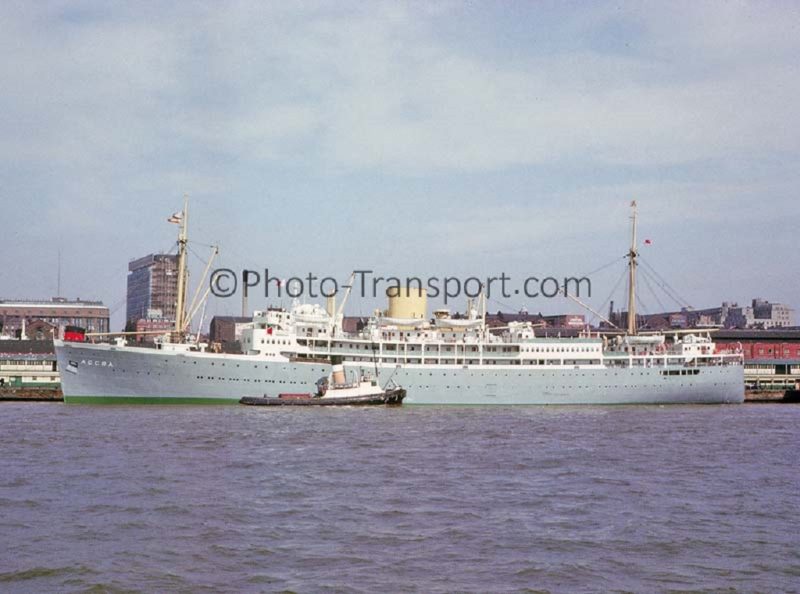
Three dozen big Woermann Linie steamers were completed between 1900 and 1914 of between 4,600 grt and 8,200 grt by the Blohm & Voss, Deutsche Werft and Reihersteig yards in Hamburg, and the Flensburger Schiffs yard, with accommodation for up to 480 passengers in three classes. The largest passenger liners had dimensions of overall length 450.0 feet, moulded beam of 55.0 feet, and moulded depth of 30.0 feet, with either triple or quadruple expansion steam reciprocating engines to give service speeds of 13.5 knots. They had four holds served by eight derricks on two masts, and two decks and a shelter deck in the holds, and four passenger decks including the long bridge deck. They were named Alexandra Woermann, Adolph Woermann, Carl Woermann, Eleonore Woermann, Eduard Woermann, Erna Woermann, Ernst Woermann, Frida Woermann, Gertrud Woerman of 1905, Gertrud Woermann of 1907, Hans Woermann, Henny Woermann, Hilda Woermann, Lucie Woermann, Professor Woermann of 1903, Professor Woermann of 1912, and Arnold Amsinck, Renata Amsinck, Lulu Bohlen, and Max Brock for Woermann Linie.
DOAL received the following steamers during the same period, mostly named after persons of high civil or military rank in Admiral, Burgermeister (Mayor), Emir, Feldmarschal (Field Marshal), General, Kronprinz (Crown Prince), Kurfurst (Elector), Khalif, Khedive, Kommodore, Muansa, Prasident (President), Prinzessin (Princess), Prinzregent (Prince Regent), Rufidji, Tabora and Kigoma. The last named was the largest when completed in 1914 of 8,123 grt by the Reihersteig yard in Hamburg with a voracious appetite for coal to burn in the boilers to raise steam for quadruple expansion steam reciprocating engines. This brought the combined total of Woermann Linie and DOAL up to 31 ships of 104,380 grt on the outbreak of war in August 1914.
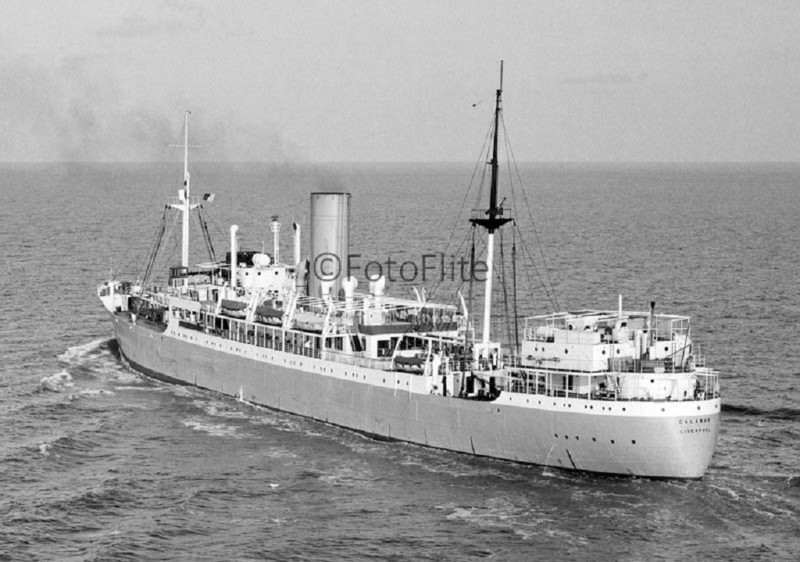
The majority of this very big fleet were war losses during the First World War, with the survivors becoming prizes to the victors and surrendered under the Treaty of Versailles. Ships were managed by British liner companies until they found buyers. Alexandra Woermann became Calypso for Ellerman Wilson Line, Eduard Woermann was operated by the Union-Castle Mail Steamship Company, Emir was operated by Elder Dempster Lines and then Mitchell, Cotts & Company as Sunheath, Erna Woermann was operated by the Union-Castle Mail Steamship Company before being sold back to DOAL and renamed Sultan, Hilda Woermann was sold to Burns, Philp & Company of Australia and renamed Marella and wore their black and white chequerboard central band on a black funnel.
Kigoma was sold to Anchor Line and renamed Algeria and then to Hamburg Amerika Line in 1922 and renamed Toledo, Lucie Woermann to New Zealand Shipping Company, Marie Woermann to Britain as a prize named Wadai and then to Rotterdam Lloyd in 1921 as Tjerimai, Martha Woermann to Britain as a prize and resold back to Woermann Linie only to be wrecked at Forcados in 1924. Max Brock as the British prize Policastria became Grey County for Norwegian owners in 1922 and was resold to Woermann in 1925 and renamed Waregga until broken up in 1933. Pangani of 1915 went to Glen Line and was then resold to Holland as Nijkerk, Paul Woermann was managed by Cunard Line as Polandia, Prinzessin went to Shaw, Savill & Albion Line and later to Union-Castle Mail Steamship Company and was resold to Messgaries Maritimes renamed General Voyron. Professor Woermann was operated by the Union-Castle Mail Steamship Company before her resale to Hugo Stinnes of Hamburg, and Safari went to Khedivial Mail Line of London and was renamed as Mansourah. The Tyne built cargo ship Tannenfels of Hansa Line had become the British prize Hunslet, and was then purchased by Woermann Linie in 1922 and renamed Waganda. Three other former German cargo ships that had become British prizes were also purchased at that time and renamed Wagogo, Wakama and Wameru.

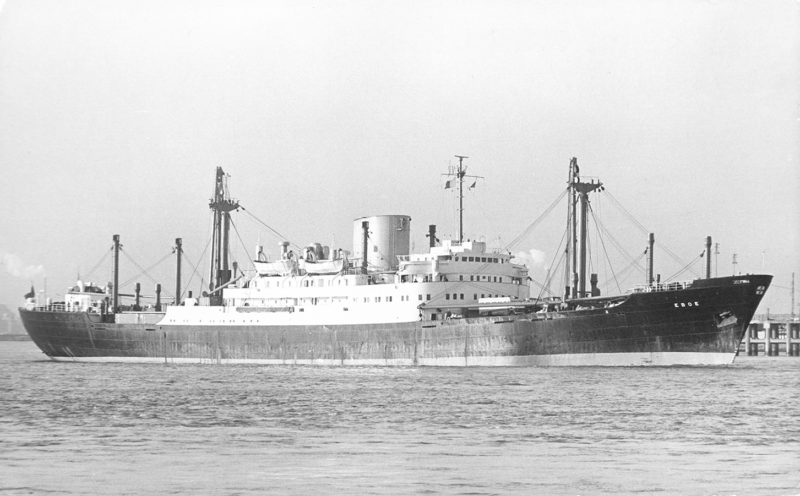
After the war was over, the revival of German shipping was under strict control by the British authorities, and the African trade could not restart with owned ships, thus the chartered Hugo Stinnes steamer Baltika arrived at Cape Town in August 1920 to begin the DOAL service again. Six passenger liners, in two sets of three, of DOAL and Woermann Linie sisters were then built by the Blohm & Voss yard in Hamburg during 1920/22. Adolph Woermann, Njassa and Usambara were of 8,600 grt and had dimensions of overall length 433.5 feet, moulded beam of 58.2 feet, and moulded depth of 37.4 feet. The hulls had two decks and a shelter deck, and there were four passenger decks with accommodation for 100 First Class, 57 Second Class and 134 Third class passengers. The public rooms were lavishly appointed, and their navigating bridges were equipped with wireless, direction finders, and submarine signalling apparatus. Four steam turbines SR geared to a single screw gave a service speed of 12.0 knots. The second trio were named Wangoni, Usaramo and Ussukuma of 7,800 grt on dimensions of overall length 418.6 feet, moulded beam of 56.2 feet and moulded depth of 27.9 feet. The hulls had two decks and a shelter deck, and there were four passenger decks with accommodation for 101 First Class, 61 in Second Class and 102 in Third Class. The public rooms were also luxurious, and they could be identified from the Adolph Woermann trio by a break in the superstructure between the ‘midships bridge deck and the poop deck houses.
Tanganjika of 8,540 grt also came from the Blohm & Voss yard in 1922 and had accommodation for 123 First Class passengers, 82 Second Class and 110 in Third Class and was sixteen feet longer and had different internal arrangements than the Adolph Woermann, Njassa and Usambara class. A step up in size was then made in 1928 with the twin funnelled sisters Ubeni and Watussi of 9,521 grt on dimensions of overall length 445.5 feet, moulded beam of 60.3 feet, and moulded depth of 29.7 feet, with accommodation on four passenger decks for 124 First Class passengers, 78 in Second Class and 132 in Third Class. Their public rooms were luxurious, and the navigating bridges were equipped with wireless, direction finders and submarine signalling apparatus. They were equipped with refrigerating machinery, and four steam turbines powered a single screw shaft to give service speeds of 14.0 knots.
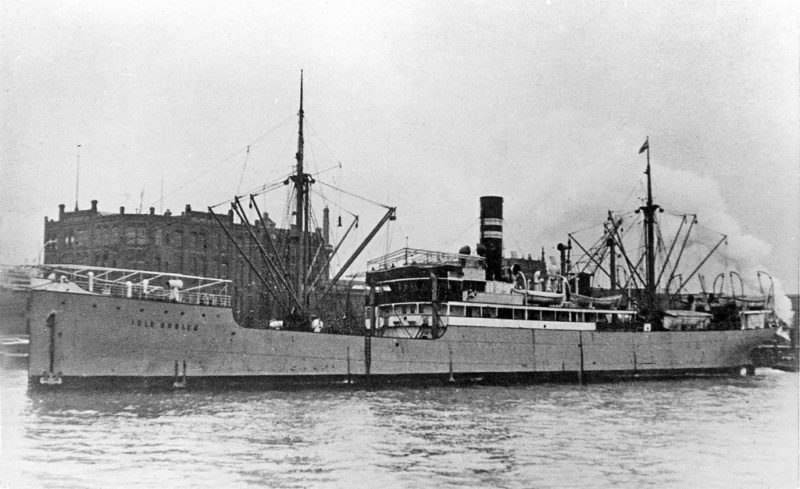
A combined total of 23 passenger and cargo ships comprised the Woermann Linie and DOAL fleets in 1932, with nine large and luxurious passenger liners, among the finest in the German passenger fleets, together with two smaller passenger and cargo-liners, Wadai and Wahehe, of 4,700 grt with accommodation for 60 First Class passengers and carried 5,070 tonnes of cargo and had been completed in 1922 by the Reiherst Schiffs yard at Hamburg. This pair were popular passenger ships with some degree of luxury, and made occasional diversions to the Seychelles, Mauritius, Reunion and Madagascar. The other dozen vessels were cargo ships and three coasters employed on the West African coasts.
The nine luxury passenger liners operated week long cruises from Hamburg to Madeira, Santa Cruze de Tenerife and Las Palmas de Gran Canaria during the lean passenger years of the 1930s, also cruises from Hamburg to Mediterranean ports and Alexandria to see the Great Pyramids of Giza near Cairo. A joint service was operated at this time with the passenger liners of Hamburg Amerika Line (Hapag) and Norddeutscher Lloyd (NDL) to West Africa, German South West Africa and East Africa using Deutschland, Hamburg, New York and Hansa of Hapag, and Bremen, Europa, Columbus and Berlin of NDL. In 1935, German shipping was still further reorganised, and the policy of decentralisation continued, and so Woermann Linie and the DOAL were separated from Hapag and NDL and ended their period of central control over Woermann. The Round Africa Line continued with the nine Woermann and DOAL passenger liners with light grey hulls and colourful funnels in Adolph Woermann, Njassa, Tanganjika, Ussukuma, Usaramo, Usumbara, Wangoni and the twin funnelled Ubena and Watussi.
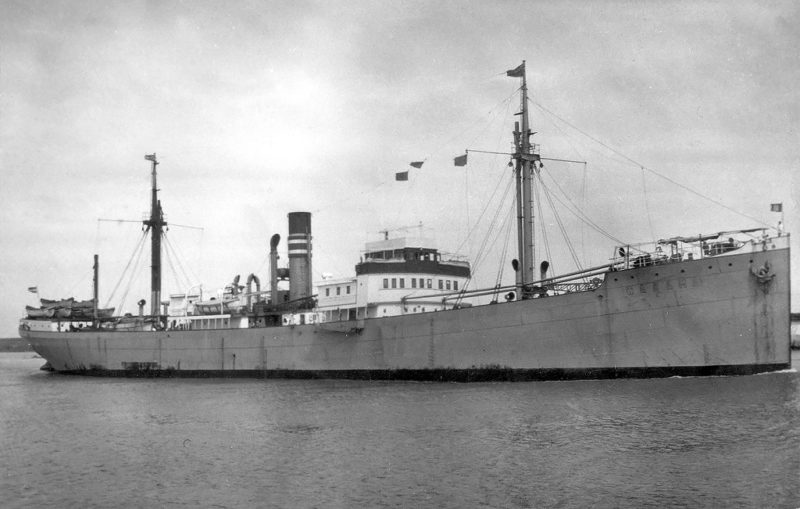
Two further and larger twin funnelled passenger liners were completed for DOAL service in 1937 in Windhuk and Pretoria of 16,662 grt with accommodation for 152 First Class passengers and 338 Third Class passengers by the Blohm & Voss yard at Hamburg. The luxury of their public rooms and First Class staterooms earned them a high reputation during the short time they were on the Round Africa Line service before the start of war. They also operated short cruises to the Canary Islands and long weekend cruises with no advertised schedule and known as ‘mystery’ cruises. They had service speeds of 17.5 knots from six steam turbines driving twin propellers. The Holland West Afrika Lijn passenger liners Amstelkerk and Maaskerk also joined the West African schedules in 1937 with accommodation for 168 cabin class passengers.
The Second World War saw the pattern of Woermann Linie and DOAL repeated and losing all of their ships as in the Great War of 1914/18. The combined Woermann Linie, DOAL and Hamburg Bremer Afrika Linie fleets formed a substantial number of 27 African traders, with thirteen passenger liners and 14 cargo ships. The survivors included the two new liners of Windhuk and Pretoria, with the former taking refuge in a Brazilian port to become a United States Navy Transport trooper. Pretoria was in Germany when war broke out, and was used as with some of her consorts as accommodation ships. She was found intact at the end of the war, and was ceded to Britain in war reparations and became the trooper Empire Doon. She was later renamed Empire Orwell and ran for the Ministry of Transport until 1963 when she was sold to Blue Funnel Line and was renamed Gunung Djati for the Moslem pilgrim service from Indonesia to Mecca, and was broken up in 1987 at Hong Kong after Indonesian Government service. Ubena also survived the war to become the British troopship Empire Ken for the Ministry of Transport and was managed by Royal Mail Lines. She visited her old haunts of Cape Town during the Suez crisis of 1956, but was broken up a year later.
Woermann Linie and the DOAL passenger service were not resumed after the end of World War II, with only a dozen cargo-liners employed with accommodation for a very few passengers on the Europe to South and South East African Conference, and the East African Conference, to ports at Walvis Bay, South African ports and Portuguese ports. The DOAL East African cargo only service operated to ports within the Cape Guardafui in Somaliland and East African ports to north of Beira and Chinde range.
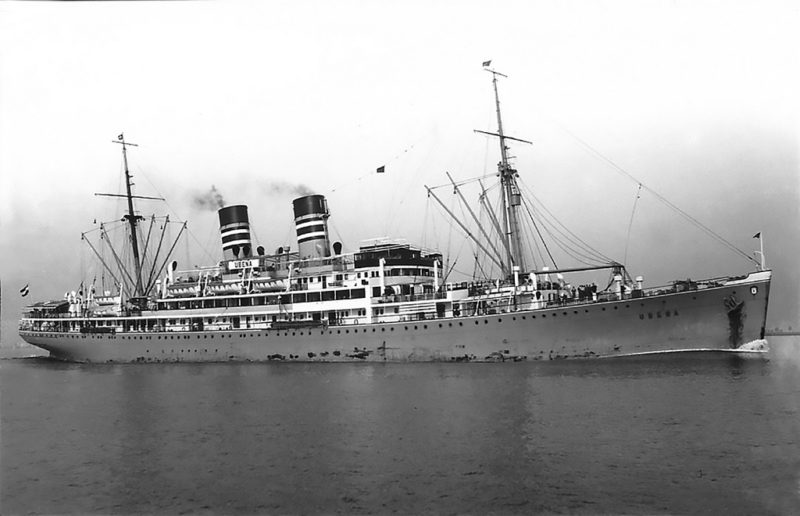
COMPAGNIE MARITIME BELGE (CMB)
Belgian attempts to set up a regular steamer service to West Africa and the Congo had failed in 1886 within a year, and it was left to British, German and Dutch interests in early 1895 to set up a West African Shipping Conference to develop these services. Elder Dempster & Company set up the Compagnie Belge Maritime du Congo (CBMC) on 24th January 1895 with the African Steam Ship Company owning all but fifty of the 4,200 shares, while Woermann Line set up the Societe Maritime du Congo (SMC) a month later. The first of a dozen Elder Dempster vessels to be transferred to the CBMC was renamed Leopoldville and sailed from Antwerp on 6th February 1895 for West Africa and Matadi. Elder Dempster & Company saw the Congo service merely as an extension of their important West Africa trade. The Belgian registered British owned ships headed from West African ports to the Congo and rounded Banana Point, where the Congo is ten miles wide, before making for the small ports of Banana, Boma and Matadi.
The second vessel transferred to CBMC from Elder Dempster & Company was launched on 11th November 1896 as Leopoldville (2), and was later transferred to the African Steam Ship Company in 1901 as Sekondi. The third ship transferred was Albertville completed in July 1896 and was renamed Jebba in June 1898 by the African Steam Ship Company. The fourth vessel transferred was Albertville (2) launched as Eboe on 9th May 1898, and she was given extra engine power and an extra knot of speed while fitting out, to make it possible for her to increase speed to catch a tide, and she reverted back to the African Steam Ship Company in 1904 as Aro. The fifth vessel transferred was Anversville, which means Antwerp town, when delivered in May 1899 but she came back to the African Steam Ship Company in March 1906 as Dakar. The sixth vessel transferred was Stanleyville of March 1900 which was wrecked on 24th May 1902 on Hoeven Rocks in Axim Bay on the Gold Coast without loss of life. The seventh vessel transferred was Philippeville of 1900 which reverted to the African Steam Ship Company in 1906 as Mandingo. The eighth vessel transferred was Bruxellesville in March 1906, completed as Zungeru in June 1904, and she reverted back to Zungeru in 1909. The ninth vessel transferred was Leopoldville (3) in 1904 but she was renamed Landana in 1908 by the African Steam Ship Company.

The last trio of transferred vessels were Albertville (3) of 4,793 grt of 1906 which became Elmina of Elder Dempster & Company in 1910, Bruxellesville (2) of 5,771 grt of 1908 which became Mocambique for Portuguese owners in 1912, both from Alexander Stephen, and Leopoldville (4) from Harland & Wolff Ltd. in Belfast in 1910, which was transferred to Elder Dempster & Company in 1914 and renamed Abinsi. The CBMC ships topped up their cargoes in West African ports, and the British parent company had purchased back ten of the dozen steamers on favourable financial terms between 1897 and the death of Sir Alfred Jones, Chairman of Elder Dempster, in 1909. The CBMC had never been allowed to show a decent profit under Elder Dempster, and was used as a subsidiary that was charged for the use of its Belgian registered steamers. The German owned SMC had dropped out of the Congo trade in 1901 amid financial crises within the Woermann parent company.
The Belgian Congo was founded in 1908 by the Belgian Government after King Leopold II had been forced to give up his private land in the Congo following severe international protests about the harsh treatment of its people. Albert Thys, the Belgian colonial financial leader, then converted the CBMC share structure in 1910 to give a Belgian majority of 60%, while Elder Dempster and Woermann were each reduced to only a 20% holding. A trio of larger passenger and cargo vessels was then completed for CBMC between 1910 and 1912 as Elisabethville of 7,035 grt from the Stephen yard on the Clyde, Albertville (4) of 7,745 grt in 1912 from the Cockerill yard in Belgium, and Anversville (2) of 7,645 grt from the Stephen yard in 1912. The last pair had dimensions of overall length 440.3 feet, moulded beam of 55.6 feet, and moulded depth of 34.4, with a fo’c’stle of length 86 feet and a poop of length 56 feet, with accommodation for 188 First Class passengers and 139 in Second Class. A speed of 14 knots was obtained from quadruple expansion steam reciprocating engines, with cargo carried on two decks and a shelter deck below in the hull. This trio had paintings and public room decorations carried out by Belgian artists and designers.
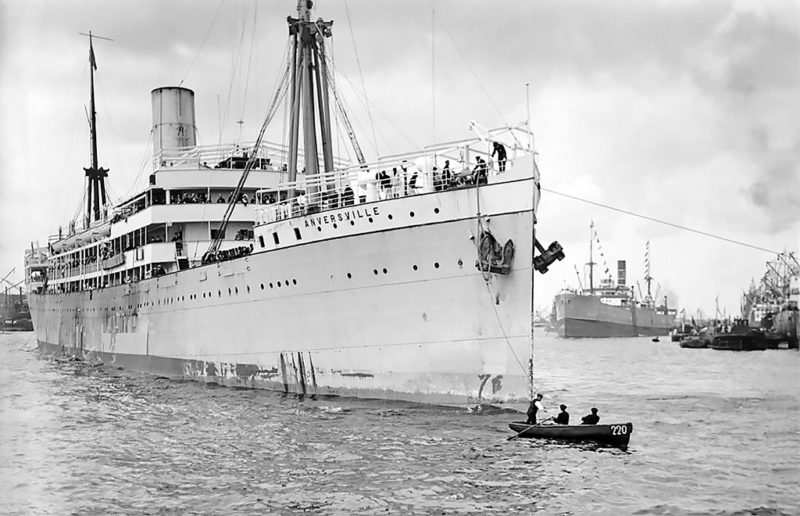
During World War I, the operation of the CMBC was moved to the offices of Elder Dempster in London, and three CMBC passenger liners were employed from British ports trading to the Congo, however Anversville (2) was forced to take refuge in Hull between 1915 and 1918. Elisabethville became a war casualty on 6th September 1917 when torpedoed and sunk in the Bay of Biscay with some loss of life. Albertville (4) served as a Red Cross hospital ship for the wounded during the war. After the end of the war, Albertville (4) and Anversville (2) resumed trading to the Congo, with Anversville (2) going to the rescue on 12th January 1920 of the Chargeurs Reunis liner Afrika on rocks at Rochebonne 23 miles from Sables d’Olonne. The Tyne built liner Ceylan of 9,063 grt completed in 1907, also of Chargeurs Reunis, and three tugs could only rescue 34 survivors from a big total of 602 people on board. Albertville (4) of 1912 was sold in 1923 to Compania Nacional de Navegacao and renamed Angola for service to Angola (Portuguese West Africa) and Mozambique (Portuguese East Africa).
Two new passenger liners were completed in 1921/22 as the sisters Elisabethville (2) and Thysville, named after the late Albert Thys, who had been an important director of the company since 1910, from the Cockerill yard in Belgium. They had accommodation for 165 First Class passengers and 114 in Second Class and of 8,300 grt and 7,280 dwt on dimensions of overall length of 459.0 feet, moulded beam of 57.0 feet and moulded depth of 29.7 feet. They had service speed of 14.0 knots from coal fired steam reciprocating engines, with additions to their speeds made by fitting superheaters. Ekari built in 1920 was purchased from Elder Dempster in 1926 and renamed Stanleyville (2) of 6,612 grt with accommodation for 90 First Class passengers in 45 double cabins, and was followed in 1928/29 by a pair of good looking twin funnelled sisters, Albertville (5) of 11,439 grt from the St. Nazaire yard, and Leopoldville (5) from the Cockerill yard. They had accommodation for 177 First Class passengers and 178 in Second Class with service speeds of 16 knots, with the dummy aft funnel later removed and their bows remodelled in refits in 1937 to give them a much better profile together with an extra two knots of speed by fitting Bauer Wach exhaust turbines. They had bunkers for 1,750 tonnes of coal or oil, and could be identified from each other as Albertville (5) had a longer poop deck, while Leopoldville (5) had an extra two derricks in front of her bridge.
The Great Depression saw the CMB fleet reduced by 20% with more than 40% of its capacity left idle at Antwerp or in the Scheldt areas. There was a fleet of five passenger liners in late 1932, but Stanleyville (2) (ex Ekari) was sold to shipbreakers that year at Blyth, leaving Anversville (2) of 1912, Albertville (5) and Leopoldville (5) of 1928/29, and Elisabethville (2) and Thysville of 1921/22 either laid up or sailing to the Congo. Compagnie Maritime Belge (Lloyd Royal) had been formed in February 1930 by the merger of CBMC with Lloyd Royal Belge to form the largest shipping company in Belgium. The parent company of the new CMB was the powerful Banque d’Outrement to give good financial management. The Compagnie Africaine de Navigation was an affiliate company from whom the CMB chartered ships to West Africa and the Congo and other ports in Africa. Lloyd Royal Belge had been formed in 1915 after the German invasion of Holland and Belgium with King Leopold II and the Belgian Government fleeing to London and building up a Belgian fleet in exile of cargo ships, which increased to eighteen cargo ships after the war and was merged into the new CMB in 1930.
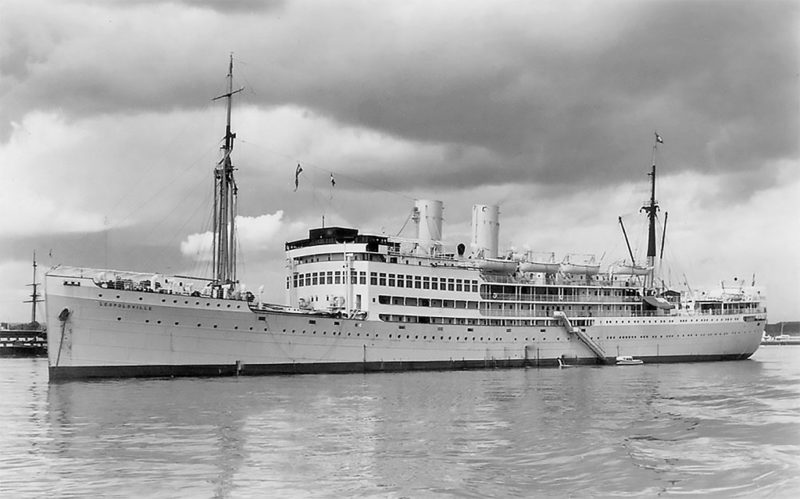
Anversville (2) of 1912 was sold for breaking up at the end of 1938 after completing the last of 134 round voyages to the Congo, and was replaced by Baudouinville in 1939 of 13,761 grt from the Cockerill yard as the flagship of the fleet. She had accommodation for 179 First Class passengers, 116 in Second Class, and one hundred in Third Class on four passenger decks with a long Bridge Deck and a crew of 250. They had service speeds of 16 knots from powerful diesel engines of 11,400 bhp and twin propellers. A sister ship, Grisarville, was under construction in Belgium at the time of the German invasion of Belgium in May 1940, but her construction was sabotaged by shipyard workers on 4th September 1944 so that she never entered service for CMB.
Elisabethville (2) sailed from Antwerp for London, while the remainder of the CMB fleet fled with their staff and agents to Bordeaux. Albertville (5) of 1928 was then sent by the French Navy to evacuate soldiers from both Brest and Le Havre, where she was bombed and sunk at Le Havre. The flagship Baudouinville was pressed into service at Bordeaux by the Germans as a headquarters ship, but on the German retreat in 1944 she was set on fire at Nantes and sank.
Leopoldville (5) was torpedoed and sunk by U487 in December 1944 while transporting American GIs in convoy from Southampton to Cherbourg with the loss of 819 lives. The Congo passenger service was carried out by only one passenger ship during the war, and losses to U boats were partially reduced by a link instead between New York and Matadi. CMB lost 22 ships with 294 seafarers killed during the war.
The two eldest sisters, Elisabethville (2) and Thysville of 1921/22 were the only CMB passenger liners left afloat at the end of the war, and became the British troopships Empire Bure and Empire Test after the end of the war. Empire Test was broken up in 1953, but Empire Bure was sold to Chandris of Greece and lived on renamed as Charlton Star for trooping and emigrant voyages. The shattered CMB fleet of passenger liners and cargo ships was completely rebuilt by the purchase of surplus American cargo ships and three new cargo-liners from the Cockerill yard, as well as five new passenger liners for the Congo trade with excellent accommodation for over 180 passengers. Albertville (6), Leopoldville (6), Elisabethville (3), Charlesville and Baudouinville (2) of 10,950 grt were completed between 1948 and 1951 as handsome sister liners from the Cockerill yard on dimensions of overall length 504.0 feet, moulded beam of 65.0 feet, and moulded depth of 31.0 feet, and a loaded draft of 27.6 feet. They had accommodation for between 188 and 217 adult passengers and 20 to 30 children, and service speeds of 17.0 knots from diesel engines built by the Seraing factory of their builders.
The construction of the Leopold Dock Sea Terminal in 1950 at Antwerp enabled CMB ships to dock at a single quay with access to passenger facilities and specialised warehouses. The first flight from Belgium to the Congo in 1935 had taken six days outward and five days homeward due to many refuelling stops. Jet aircraft carried 40,000 passengers in 1953, and began to take Belgian and African passengers to the Congo away from the passenger liners in the late 1950s and mid 1960s. Baudouinville (2) was renamed Thysville (2) in 1957 and sold to the Vestey empire in 1961 to become Anselm of Booth Line, Iberia Star of Blue Star Line, and finally Austasia of Austasia Line and was broken up in Hualien in China in 1973.
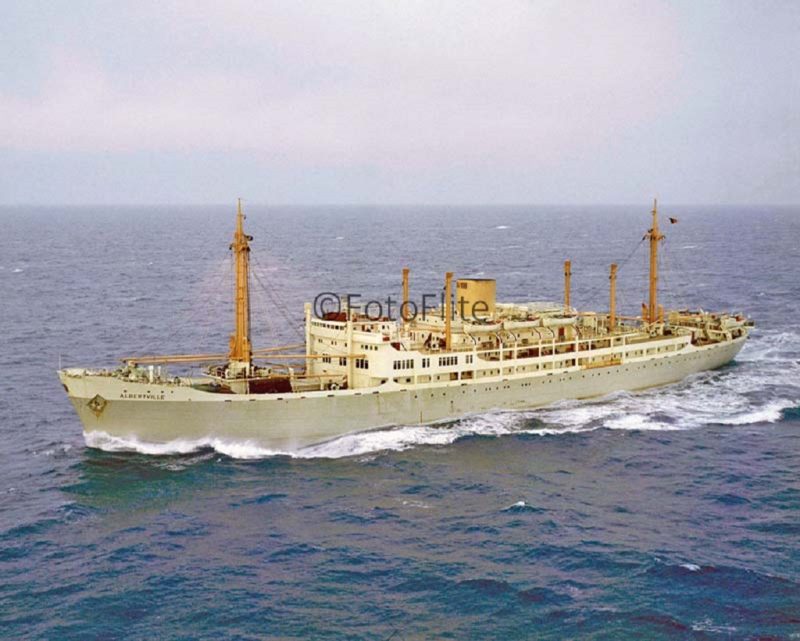
Charlesville was sold in 1967 to become Georg Buchner and later served as a seafarer training ship at Rostock from October 1977 to 2013. She sank under tow on 30th May 2013 in the Baltic off Gdansk while on her way to shipbreakers at Klaipeda in Lithuania. Leopoldville (6) was transferred in 1967 to Compagnie Maritime Congolaise as P. E. Lumumba and arrived at Tamise in Belgium for breaking up in May 1973. Elisabethville (3) was broken up after a bad fire at Antwerp in 1968, and was followed by Albertville (6) in 1973.
A further pair of French designed passenger ships joined CMB in 1956/57 as Jadotville from the Penhoet yard at St. Nazaire, and Baudouinville (3) of 13,724 grt from the Cockerill yard with accommodation for 300 one class passengers with a crew of 196. They had dimensions of overall length 557.0 feet and a moulded beam of 70.2 feet, with a forward well deck at number 2 hold and sixteen derricks to work cargo. A maximum speed of 18 knots was obtained from Parsons geared turbines by the builders generating 12,500 shp to a single propeller. Jadotville made her maiden voyage from Antwerp to Matadi on 23rd July 1956, followed by Baudouinville (3) on 2nd November 1957. However, after short careers of three to four years, they were sold in January 1961 to P. & O. to become Chitral and Cathay for the Far East service ending at Yokohama. They had a sister in Ancerville of 14,224 grt built in 1962 at the Penhoet yard for Cie Navigation Paquet of France for West African services.
The Belgian Congo had been granted independence on 30th June 1960 after much nationalist unrest among its people. The setting up of Compagnie Maritime Congolaise (CMC) in 1967 further reduced CMB fleet requirements for passenger and cargo transport. A last echo of the great West African and Congo passenger fleet of CMB was provided by the passenger cargo-liner Fabiolaville of 13,481 grt completed by the Cockerill yard in 1972 with excellent accommodation for 71 First Class passengers. However, the United Nations introduced the 40/40/20 rule in 1974 whereby developing nations could claim 40% of their own trade for themselves, leaving 40% for colonial companies, and 20% for cross traders. The central African trade of CMB slumped to only 37.5% of the previous total, and Fabiolaville was sold in 1989 to the Chinese and renamed Hai Hua for the China to Inchon in Korea passenger service.
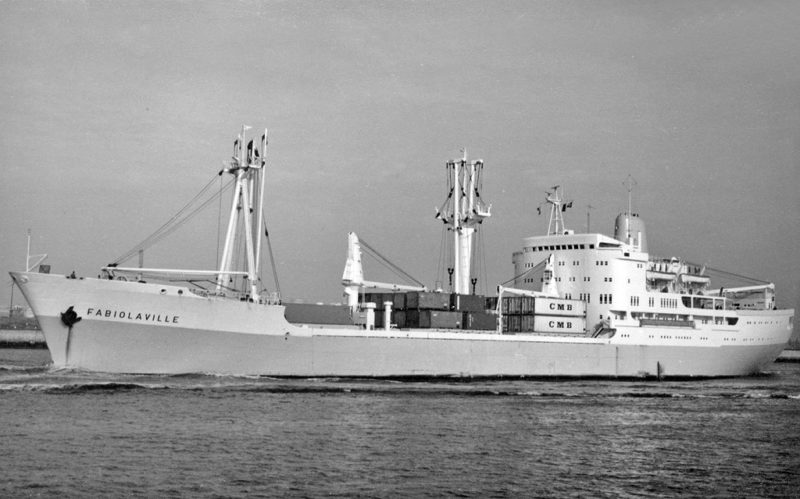
POSTSCRIPT
My collection of maritime memorabilia includes a beautiful table mat from the lovely white hulled Elder Dempster Lines liner Aureol that was used in her public rooms and bars on her Promenade Deck, as I remember seeing her many times during 1972/74 in the Western Docks at Southampton. Elder Dempster Lines continued on the UKWAL (U. K. to West Africa Line) service with six engines aft ‘S’ class of 12,090 dwt with 372 TEU container capacity from 1973 until the end of 1986, when UKWAL was reorganised to accommodate the Nigerian Green Line and Ghana Black Star Line fleets matched by a reduction in Elder Dempster participation. The West African service was then carried out during 1986/89 by four engines aft ‘M’ class of 772 TEU capacity, with Memnon arriving back in the U. K. at the end of April 1989 to end the Elder Dempster Lines cargo only service.
Woermann Line and the Deutsche Ost Africa Line (DOAL) became the DAL Deutsche Afrika Line, founded by the Essberger family in 1924, with echoes of the Woermann Line and their ships with ‘W’ prefixes in the container ship Wakamba, formerly Woermann Wakamba, and still trading into the 21st century.
DAL Deutsche Afrika Line is still trading today with headquarters in Hamburg-Altona on the river Elbe. The container ship DAL Kalahari of 7,450 TEU capacity was built in 2011 and is used on the Southern Africa Europe Container Service (SAECS) with ‘Deutsche Afrika Linien’ in bold capitals on both sides of her blue hull.

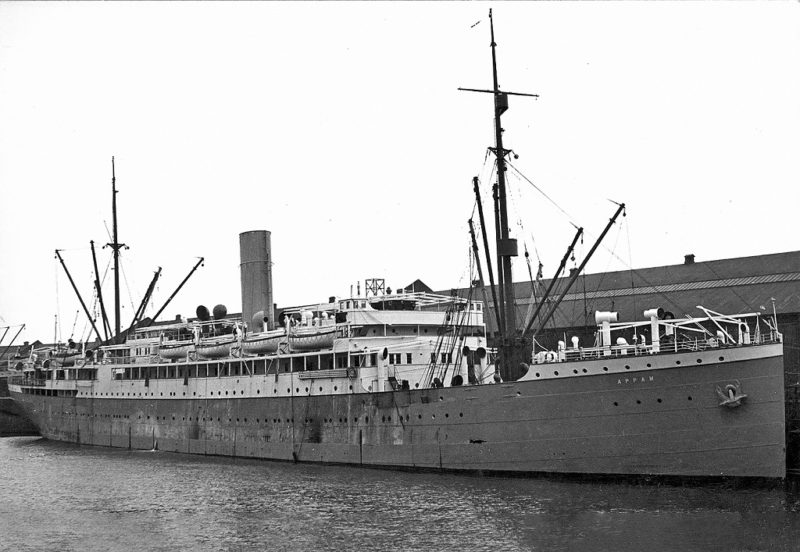
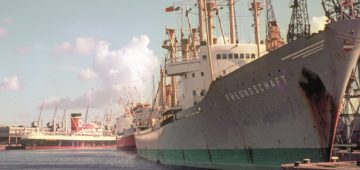


Comments
Sorry, comments are closed for this item